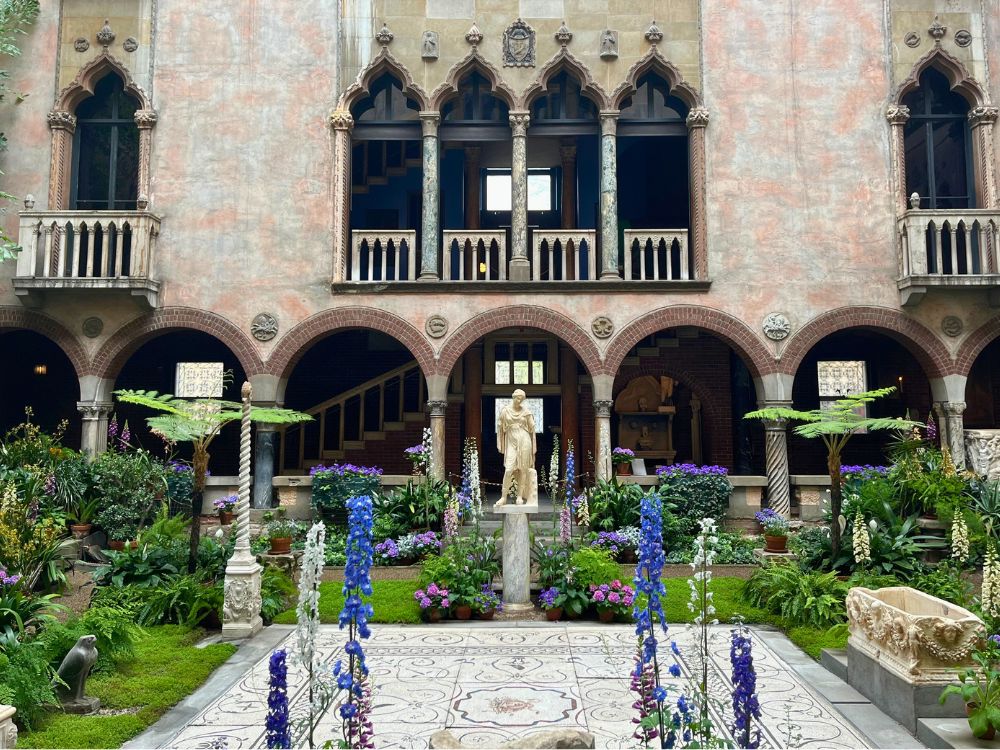Weekend Wanderings: Experience The Isabella Stewart Gardner Museum on Your Next Visit to Boston5/2/2025
Have you been to Boston lately? Over the years, I have had the chance to visit this vibrant city on numerous occasions. When the kids were younger, we did all the fun activities like riding the Duck Boats, visiting the New England Aquarium, and following the red bricks on the Freedom Trail. We have eaten arancini and cannoli, lobster rolls, and even a Fenway Frank at the ballpark. On two occasions, we timed our trip with the Saint Anthony’s Feast, an event that has been happening in Boston’s North End for over 100 years. In anticipation of another long weekend visit, I was looking for something new to do and realized we had never been to the Isabella Stewart Gardner Museum. Unfortunately, after purchasing tickets a few weeks in advance, I had to cancel my Boston trip at the last minute. My husband and daughter were still able to go, and had a wonderful visit to the museum and contributed their insight and photos for this blog.
*This post contains affiliate links; if you purchase something familyTravelsUSA may receive a small commission. As always, opinions are my own.
So what is the story behind the museum? It was the dream of Isabella Stewart Gardner, a young woman from a wealthy New York City family who moved to Boston after marrying Jack Gardner in 1860 at the young age of 20. Isabella began her art collection around 1878 starting with manuscripts and rare books, and added significant artwork to her collection in the 1890’s after several visits abroad. After years of collecting paintings, manuscripts, textiles, and other works, and inspired by a grand palace in Venice that she visited in 1884, she and her husband discussed plans to create a museum. After her husband died suddenly in 1898, Isabella moved forward with their plan to design and build the museum.
Windows, columns, and other items purchased in Italy by Isabella and her husband were incorporated into the museum design, and she was very involved in the day-to-day building process. The museum was completed in 1901 and became home to her impressive collection when it opened to the public in 1903.
It’s hard to imagine living in a home surrounded by such a magnificent art collection, of various mediums, artists and periods, but while Gardner arranged her treasures on the bottom three floors of the house, she lived on the fourth floor. This allowed her to continue to add to and arrange her collection throughout the years. Her passion and dedication extended beyond her life; her will is clear, that nothing could be moved after her death or the whole collection must be shipped to Paris and sold at auction!
Today, three floors are open to the public, with numerous rooms on each floor, including the Blue Room, Dutch Room, the Titian Room, and the popular Courtyard. The collection visitors see today reflects Isabella Stewart Gardner’s original thoughts about themes and placement. It is also the reason why empty frames hang where pieces, including Rembrandt’s Christ in the Storm of the Sea of Galiee and Édouard Manet’s Chez Tortoni once hung.
What makes the Isabella Stewart Gardner Museum worth a visit? For one, there is the unsolved theft of 13 works of art over 35 years ago! Before you go, listen to the stories and read more about what happened on that fateful night in March, 1990. This true crime in real life story described how thieves left with works of art from masters’ including Rembrandt van Rijn, Vermeer, and Degas. Today, there is still a hefty reward of ten million dollars for “information leading directly to the safe return of the stolen works.”
Another cool aspect of the museum is the sheer volume and variety of art to take in and the way that pieces are lining the walls and ceilings. Some of the more well-known pieces include Boticelli’s Virgin and Child With an Angel, and the Isabella Stewart Gardner portrait painted by John Singer Gardner. As mentioned earlier, all of the artwork is still displayed in their original locations throughout the museum. When you enter the Dutch room, pop on your headphones and take a few minutes to listen to the audio The Theft: An Immersive Audio Walk describing the six pieces stolen from this room.
The other thing to expect is that unlike most museums, there are no descriptions of the art or the artist who painted it. This was done by design, Isabella’s intention is for visitors to start an emotional-reaction and academic conversations about the piece they are enjoying. For some, this may not be the optimum way to appreciate the art, but visitors can scan a QR code in each room to access a Room Guide. Some of the room guides offer short audio walks for further insight. Also to improve your experience, rooms are monitored for crowd size, and you may experience a brief wait to get into the more popular rooms.
The central courtyard is also a popular spot in the museum. Expect to find seasonal flower displays, grown in the museum's nearby greenhouses and nursery, nestled among the sculptures. Get there early to enjoy this beautiful space.
The museum also hosts special exhibits, like the Water of the Abyss: An Intersection of Spirit and Freedom on display through May 25, 2025. It showcases the work of Haitian artist Fabiola Jean-Louis with cool materials like shells, glass, and paper.
If you work up an appetite while exploring the Isabella Stewart Gardner Museum, we suggest you head over to Boston’s North End for a taste of Italy! And if you are visiting some of Boston’s other popular attractions like the New England Aquarium or the Museum of Science, consider purchasing a CityPASS® ticket for discounted admission. Know Before You Go *Reserve tickets ahead of time to guarantee entry *Bring headphones to listen to audio on your phone *Enter the museum when it first opens to try to get ahead of the crowds *Consider looking at the Isabella Stewart Gardner Museum room guide before you visit to better understand the museum layout *Discounted parking is available at the nearby Simmons School of Management Garage or the lot at the Museum of Fine Arts. The museum is also accessible by bus or subway.
0 Comments
Your comment will be posted after it is approved.
Leave a Reply. |





 RSS Feed
RSS Feed
